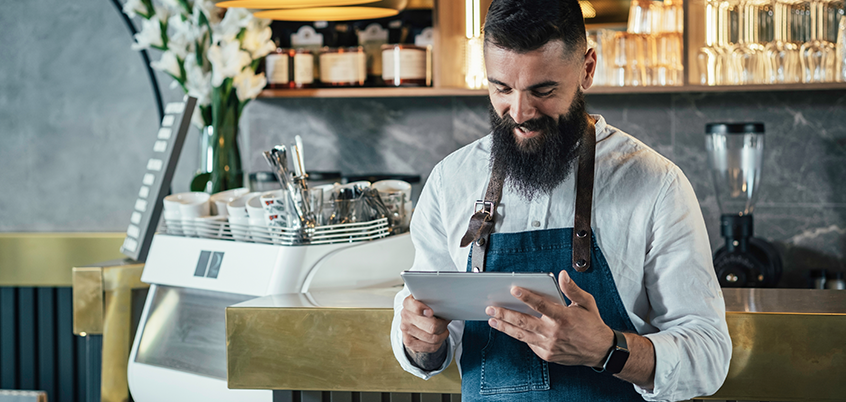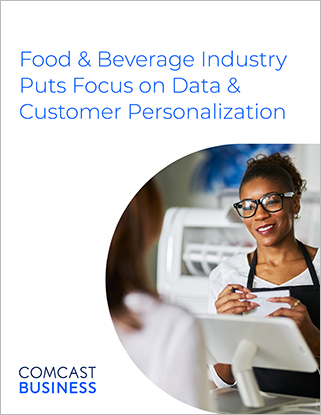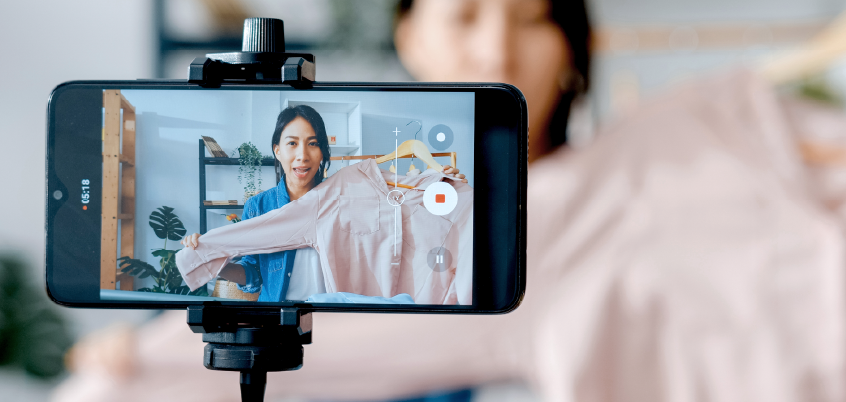Food & Beverage Industry Puts Focus on Data & Customer Personalization

Introduction
Food and beverage companies are looking to increase their use of digital technologies to help personalize the customer experience in various ways, an effort they view as key to driving growth. It’s all part of a larger move to embrace and reap the benefits of digital transformation, including increasing customer engagement and efficiency while reducing costs.
This is the big-picture view from a survey of more than 200 IT executives in the food and beverage industry conducted by DemandScience in collaboration with Comcast Business. Nearly a third of respondents said they intend to improve the use of business analytics for decision-making. This may apply to everything from featured menu offerings to providing highly personalized customer promotions and rewards programs. Effective use of analytics can also help companies optimize their supply chains and reduce costs.
But it all requires an effective IT foundation on which to build, both inside restaurants and connecting to the broader Internet and cloud resources. In this report, we’ll take a look at the plans food and beverage IT executives have, the IT investments they’re making in order to realize them and the benefits they expect to reap.
Top Priorities: Customer Experience, Digital Initiatives
When asked to name their top business priorities, IT executives who work for food and beverage companies, chiefly restaurants, taverns, and other eateries, indicated they are focused on:
- 35% Upgrading the customer experience
- 34% Digital business growth
- 31% Improving the use of business analytics for decision-making
It’s clear that survey respondents believe applying business analytics to customer data is key to driving improved, highly personalized customer experiences. And they are certainly not alone. The global big data and business analytics market was valued at $168.8 billion in 2018 and is forecast to reach $215.7 billion in 2021, according to Statista.1 Tech Jury reports 97.2 percent of organizations are investing in big data and AI – restaurants included.2
Restaurants have plenty of motives for using data to inform personalization efforts. A recent story at Modern Restaurant Management (MRM) outlined a number of sound reasons, including the ability to treat customers like you know them, such as by offering them their “regular” sundae, sandwich or the like, served as they always order it.3
Such personalized touches tend to increase loyalty, which is crucial given it costs five times more to attract a new customer than to keep an existing one. That makes occasional rewards offered through loyalty programs more than worthwhile. MRM noted a recent survey found 39% of customers say loyalty and rewards programs encourage them to spend more at restaurants that offer them, making it the most frequently cited way restaurant customers say they would be encouraged to spend.4
Data can also help restaurants predict trends, such as which menu items are likely to become popular. Similarly, real-time data makes it easier to track inventory, including items that are over-stocked or nearly depleted – so customers are never disappointed because their favorite item isn’t available.
Ensuring inventory is available relates to optimizing the supply chain, which was a business priority for 30% of survey respondents. That, of course, also depends on a steady stream of data from various players along the supply chain – as well as data analytics to synthesize it and inform decision making.
Tech Plans to Bolster Customer Experience
With so many of their business goals centered around improving the customer experience, it’s little wonder that respondents to the survey have technology plans that correlate with that objective. Chief among them is mobile ordering and payment applications, cited by nearly half of respondents (47%). Closely related is omnichannel customer communications, cited by 40% of respondents. Omnichannel technology solutions could involve providing various options for customers to receive marketing messages and to place orders, encompassing mobile apps, websites, kiosks and drive-thru. Another related technology – contactless, frictionless transactions, such as online and pick up in store or curbside and tap-to-pay – was cited by 32% of respondents.
Having sound strategies for both mobile apps and websites is important. Restaurant digital orders surged 124% in the first year of the pandemic, according to market researcher NPD Group.5 Now restaurants are turning to mobile apps, typically tied to loyalty programs, to not only hang on to new mobile customers, but make them more lucrative.
For those customers who don’t want to bother downloading an app, it’s imperative for personalization efforts that restaurant websites offer similar functionality, encouraging customers to identify themselves. Companies should seek to build ecosystems of technologies, including mobile apps and in-store self-order kiosks, all of which can provide a personalized experience.6
Nearly a third of survey respondents (32%) also plan to implement artificial intelligence (AI) and machine learning (ML) technologies for data insights and automation. Such insights can be a significant driver for personalization efforts.
For example, AI technologies can power customer recognition systems that identify customers as they walk in the door of a restaurant, based on either their mobile app or other identifiers. If the customer has already placed an order, a push notification to their phone can tell them when it’s ready and where to pick it up. Customers who haven’t yet placed an order can receive personalized offers, including prompts related to their most recent purchases. Some restaurants are also extending such personalized offers to drive-thru customers.7
Investments Reflect Personalization Focus
Of course, what IT executives want to implement and what actually winds up in the budget can vary. It’s interesting, then, to look at the technologies for which respondents to the survey say they are increasing investments.
The top response was security, chosen by 43% of respondents – no surprise given the ever-present risks that cybersecurity threats present. But it’s also prudent, given how a security breach, especially one involving customer data, can torpedo customer trust in some of the crucial underpinnings of a strong customer personalization experience, including mobile apps and websites.
Mobile ordering and payment applications were the next-most popular technology investment, cited by 41% of respondents. A healthy 38% are investing in AI and ML technologies for data insights and automation while 37% will increase investments in omnichannel customer communications.
Keeping in mind many companies may have already invested in such technologies, those numbers point to robust interest in technologies that can advance personalization efforts.
Benefits of Personalization
A focus on personalization makes sense given the benefits to be had. Leveraging data analytics to drive personalized communications can boost incremental sales by 5% or more among individual loyalty program members, according to Boston Consulting Group’s Martin.8
That can come from suggesting items based on the customer’s own purchasing history or the buying patterns of other, similar customers. Customers who religiously order the same meal once per week may be enticed by an offer encouraging a second visit, good for a limited time. Or data from other customers can be used to suggest upselling offers based on what’s popular at various times of day.
Such data analytics is a core competency of the third-party delivery firms that restaurants increasingly relied on for sales during the pandemic. They routinely target customers with various offers, right down to suggesting a food delivery when it’s raining.9
Loyalty programs can serve similar offers, and it’s hard to overstate their importance in terms of driving sales.
One large national restaurant chain recently recorded more than half of its quarterly sales at U.S. company-owned locations from its loyalty program members. Mobile orders accounted for 26% of the firm’s U.S. company-owned transactions, up from 18% a year earlier.10
The Data-Driven Back of the House
One step removed from personalized customer loyalty apps are the various ways data can help inform back-of-the-house operations, with the same goal of delivering a great customer experience.
This may include a modern, cloud-based point-of-sale (POS) system that can create efficiencies by automating processes such as payments and ordering. Cloud-based POSs can be easier to implement than their on-premises predecessors and can be customized to your particular restaurant. They can also integrate with your customer database, helping to collect the data that supports your personalization efforts.11
Similarly, cloud-based inventory management systems can help streamline the job of making sure appropriate levels of supplies are always on hand, from chicken to napkins.
These tools help automate inventory management processes including re-ordering, while monitoring inventory levels in real-time.
By applying technologies such as AI and ML to the reports generated by inventory management systems, restaurants can sense or predict demand for various menu items – and order accordingly. That helps reduce waste attributed to less popular items and maximize profits for those customers can’t get enough of – by ensuring you don’t run out.
Detailed data can also be used for menu modeling or engineering, which is intended to help restaurants determine whether their inventory, recipes, menu design and pricing strategy are driving maximum profitability. These models consider a whole host of factors – including sales per head, promotions as a percent of sales, gross average check and lots more – to help restaurants produce actionable insights. That includes the effect of price increases on various menu items, based on data gathered from your most and least loyal customers.12
Tech-Driven Personalization, Built on a Sound Foundation
Restaurants have no shortage of technologies at their disposal to help them achieve the sort of customer personalization that drives profits. But whether it’s mobile apps, robust websites, frictionless transaction processing or AI and ML tools, they all rely on restaurants having sound network and security infrastructure in place.
That means WiFi throughout the restaurant and fast, reliable wide-area connections to cloud-based resources such as POS systems. Cybersecurity services are also a must, because no restaurant – no matter how large or small – is immune to phishing attacks, malware, ransomware and more.
Create a differentiated dining experience and enhance systems performance with innovative technologies from Comcast Business. Learn more at business.comcast.com/restaurants-food-services
[1]“Revenue from big data and business analytics worldwide from 2015 to 2022,” Statista
[2]“25+ Impressive Big Data Statistics for 2021,” TechJury
[3]“Harnessing Data and Using Automation to Deliver a More Personalized Dining Experience,” Modern Restaurant Management
[4]Ibid
[5]“Beyond the punch card: Restaurants lean into loyalty programs to hold onto pandemic digital gains,” CNBC.com
[6]Ibid
[7]“Beyond the punch card: Restaurants lean into loyalty programs to hold onto pandemic digital gains,” CNBC.com
[8]“Restaurants Play Catch-Up with Data Analytics to Personalize the Fast-Food Experience,” CO, U.S. Chamber of Commerce
[9]Ibid
[10] “Beyond the punch card: Restaurants lean into loyalty programs to hold onto pandemic digital gains,” CNBC.com
[11] “Implementing a New POS System: 5 Strategies for Your Staff,” NextRestaurants
[12] “Restaurant menu modeling 101,” Nation’s Restaurant News
Recent survey showing analytics are driving digital investment for food & beverage industry
Locked Content
Click on the button below to get access
Unlock NowOr sign in to access all content on Comcast Business Community
Resource Center
Learn how Comcast Business can help
keep you ready for what's next.











